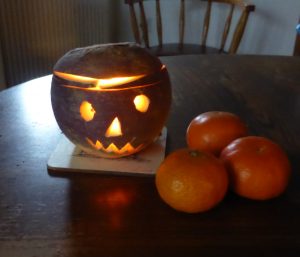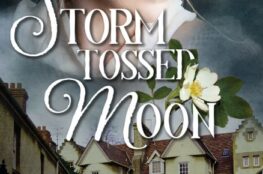We decided to go back to Scottish tradition this Halloween, where we’ve been celebrating this festival since time immemorial. Our lantern this year is carved from a turnip.

OK, I admit that Andrew the Neep-Heid is somewhat roughly-hewn and has a face only a mother could love but he’ll do sterling service on the gate-post tomorrow evening, lighting the way for any passing guisers.
But gin the auld folks’ tales are richt,
An’ ghaists come hame on Hallow nicht…
Violet Jacob
The traditional Scottish guiser is in disguise, that’s where the word comes from. This was a ploy designed to confuse and hide your real identity from witches, ghosts, malevolent spirits and fairies, all of whom might wish you harm. The Scottish variety of fairies are quite malevolent too. We have a rowan tree outside the front door, so that’ll keep the witches away. We’ll be on our own with the fairies but some of the ghosts will be welcome.
There used to be an element of ‘trick or treat’ in some parts of Scotland. According to F Marian McNeill’s classic work on customs of the Scottish year, The Silver Bough, lobbing a ‘fusillade of turnips’ at people’s doors was quite common at one time. This softened into guising, knocking at the neighbours’ doors in the hope of being invited in to do your party piece in return for an apple, a tangerine, a handful of sweeties or a coin or two.
There are other Halloween traditions, perhaps most notably dooking for apples. This involves bending over a bowl filled with water and bobbing apples, your hands behind your back, and picking up an apple with your teeth. It helps if they have a good long stalk.
My mother told me that as a child in Aberdeenshire in the 1920s, she used to go out guising on Hogmanay as well as at Halloween. On Hogmanay, Old Year’s Night, 31st December, they would go to the neighbouring crofts and chant a wee rhyme:
Rise up, guid wife, and shak’ your feathers,
Dinna think that we are beggars,
We’re just bairns come oot tae play,
Rise up, and gie’s oor Hogmanay.
Our feet’s cauld, oor sheen’s thin,
Gie’s a piece, and let’s rin!
Sheen is a variant on shoon, the old plural of shoe. A piece is a nice wee something to eat, often bread with something between it. In modern Aberdeenshire, a cake is still known as a ‘funcy [fancy] piece’.
It was years later before I discovered that what my mother and her friends were reciting was a fragment of The Goloshan, an ancient play that was probably performed in Scotland on the last night of the year since pagan times.
The celebration of Halloween too is a time-honoured part of our Scottish heritage, a time to mark the transition to the dark nights of winter and to remember those we have lost and those who came before us, back down through the centuries to the early folk.
Halloween is also a night to be safely scared. Marian McNeill listed a delicious array of those our forebears ‘believed to be at large on this occult night – ghoulies, ghaisties and bogles; fairies, banshees and gruagachs; witches, warlocks and wurricoes; brownies, urisks and shelly-coats; kelpies and water-bulls; spunkies, gnomes, trolls and sprites; the whole unhallowed clanjampfrey of the netherworld.’


31st October 2016
Thoroughly enjoyed your little piece on Halloween. Love reading and hearing about the old traditions. Hope you have more to share with us. Take care.